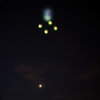Galactic Penguin SST
BANNED

- Joined
- Aug 10, 2017
- Messages
- 1,454
- Reaction score
- 1
- Country
- Location
What Is HAARP?
The High-frequency Active Auroral Research Program (HAARP) is a program jointly managed by the U.S. Air Force and U.S. Navy.
The data obtained from the proposed research would be used to analyze basic ionospheric properties and to assess the potential for developing ionospheric enhancement technology for communications and surveillance purposes.
Because of its strong interaction with radio waves, the ionosphere also interferes with U.S. Department of Defense (DOD) communications and radar surveillance systems, which depend on sending radio waves from one location to another.
Ionospheric disturbances at high latitudes also can act to induce large currents in electric power grids; these are thought to cause power outages.
The HAARP facility utilizes powerful, high frequency (HF) transmissions and a variety of associated observational instruments to investigate naturally occurring and artificially induced ionospheric processes that support, enhance or degrade the propagation of radio waves.
There are several HF transmitters located throughout the world which conduct research similar to that proposed by HAARP. However, no facility, located either in the U.S. or elsewhere, has the transmitting capability needed to address the broad range of research goals which HAARP proposes to study. The most capable HF transmitters currently operating are located in Russia and Norway and have effective radiated powers (ERP) of roughly one billion watts (1 gigawatt). One gigawatt of ERP represents an important threshold power level, allowing significant radio wave generation and analysis of key ionospheric phenomena. The HAARP facility is designed to have an ERP above one gigawatt.
Source: haarp.alaska.edu/haarp/index.html
HAARP experiment caught on amateurs' camera
Friday, Jun. 30, 2017
After multiple scrubbed launch attempts over the last 30 days, a Terrier-Improved Malemute sounding rocket blasted off from NASA's Wallops Flight Facility in Virginia at 4:25 a.m. on June 29th.
The resulting is a new display of "space clouds" :
Amateur astrophotographer Christopher Becke captured this star-trailed image from Williamsburg, Virginia. "I was 82 miles from the launch site but had no trouble seeing the rocket or the clouds," he says.
During the 8-minute flight, the rocket deployed 10 canisters about the size of soft drink cans more than 100 miles above Earth's surface. The canisters dispensed barium, strontium and cupric-oxide, which interacted to form blue-green and red vapors visible from New York to North Carolina. According to the space agency, the chemicals "pose[d] no hazard to residents along the mid-Atlantic coast."
"As the canisters fired, the erupting colors were vivid and brilliantly apparent," reports onlooker Susan Milligan of Williamsburg VA. "The photos hardly do them justice."
Such clouds allow scientists on the ground to visually track particle motions at the edge of space, giving them new insights into the dynamics of Earth's ionosphere.

Taken by Joe Stieber on June 29, 2017 @ Wharton State Forest, NJ

Taken by Christopher Becke on June 29, 2017 @ Williamsburg, VA

Taken by Kurt Fanus on June 29, 2017 @ Richmond VA
Source:
nasa.gov/feature/wallops/2017/nasa-wallops-rocket-launch-lights-up-the-mid-atlantic-coast
The High-frequency Active Auroral Research Program (HAARP) is a program jointly managed by the U.S. Air Force and U.S. Navy.
The data obtained from the proposed research would be used to analyze basic ionospheric properties and to assess the potential for developing ionospheric enhancement technology for communications and surveillance purposes.
Because of its strong interaction with radio waves, the ionosphere also interferes with U.S. Department of Defense (DOD) communications and radar surveillance systems, which depend on sending radio waves from one location to another.
Ionospheric disturbances at high latitudes also can act to induce large currents in electric power grids; these are thought to cause power outages.
The HAARP facility utilizes powerful, high frequency (HF) transmissions and a variety of associated observational instruments to investigate naturally occurring and artificially induced ionospheric processes that support, enhance or degrade the propagation of radio waves.
There are several HF transmitters located throughout the world which conduct research similar to that proposed by HAARP. However, no facility, located either in the U.S. or elsewhere, has the transmitting capability needed to address the broad range of research goals which HAARP proposes to study. The most capable HF transmitters currently operating are located in Russia and Norway and have effective radiated powers (ERP) of roughly one billion watts (1 gigawatt). One gigawatt of ERP represents an important threshold power level, allowing significant radio wave generation and analysis of key ionospheric phenomena. The HAARP facility is designed to have an ERP above one gigawatt.
Source: haarp.alaska.edu/haarp/index.html
HAARP experiment caught on amateurs' camera
Friday, Jun. 30, 2017
After multiple scrubbed launch attempts over the last 30 days, a Terrier-Improved Malemute sounding rocket blasted off from NASA's Wallops Flight Facility in Virginia at 4:25 a.m. on June 29th.
The resulting is a new display of "space clouds" :
Amateur astrophotographer Christopher Becke captured this star-trailed image from Williamsburg, Virginia. "I was 82 miles from the launch site but had no trouble seeing the rocket or the clouds," he says.
During the 8-minute flight, the rocket deployed 10 canisters about the size of soft drink cans more than 100 miles above Earth's surface. The canisters dispensed barium, strontium and cupric-oxide, which interacted to form blue-green and red vapors visible from New York to North Carolina. According to the space agency, the chemicals "pose[d] no hazard to residents along the mid-Atlantic coast."
"As the canisters fired, the erupting colors were vivid and brilliantly apparent," reports onlooker Susan Milligan of Williamsburg VA. "The photos hardly do them justice."
Such clouds allow scientists on the ground to visually track particle motions at the edge of space, giving them new insights into the dynamics of Earth's ionosphere.
Taken by Joe Stieber on June 29, 2017 @ Wharton State Forest, NJ
Taken by Christopher Becke on June 29, 2017 @ Williamsburg, VA
Taken by Kurt Fanus on June 29, 2017 @ Richmond VA
Source:
nasa.gov/feature/wallops/2017/nasa-wallops-rocket-launch-lights-up-the-mid-atlantic-coast



